There’s something magical about living right in the heart of a forest where you open up your door to a passing deer, butterflies flitting about the wild flowers and an eagle circling above. The pressures of the city don’t exist for you and time doesn’t have the same vice grip power. You chose this life to keep things simple, to appreciate and live in harmony with mother nature and for the most part you do very little to change your surroundings. The only exception for you and so many others who have decided to commune with nature and enjoy the freedom that this brings is pests. Insects, arachnids, rodents and destructive animals have a way of ruining anyones castle whether in a serene setting of the woods or the hustle and bustle of the city jungle.
Common pests in the woods
Some of the most common and persistent pests for homes in the woods are spiders, ants, peridomestic roaches, rats and mice, fleas, wasps and animals such as raccoons. To them your home is much like an oasis in the desert. Sure they could get along just fine without you but with the home emitting smells, heat and light they can’t resist at least checking you out. Add to this the shelter your eaves or crawl space might offer, food from the dog dish or perhaps feed for any yard animals with a steady supply of water and you have a bright and shining beacon in a world that relies so heavily on camouflage. As insects move in this brings other predatory pests and before you know it your serene little world could be a virtual nightmare awash with creepy crawlies in every corner.
It’s a team effort
In my neck of the woods (pun intended) we have MANY homes we service that are smack in the middle of the forests. People rely on our service to keep them bug free but we make sure there is no illusion that our work alone will achieve this goal. IPM (integrated pest management) is a program and a term that much of the public embraces because it sounds like a good and responsible thing to do. The problem is in my opinion that when they learn it involves any work on their part it suddenly loses it’s luster. However for homes so deep in the enemies territory IPM is a must but if you like we can call it by a different name so it won’t seem like work.
Honey do’s
The first thing do do is try and seal things up. Loose screens, doors that need weather strips and crawl spaces need to be blocked off so pests cannot enter. Typically we have mobile homes or log cabin type structures and these are almost always up off the ground. If you chose lattice or some other type of skirting (or none at all) that is open around the base you will at least need to seal up the areas where pipes and utilities come in through the floor. Expanding insulation in a can does well for this and you can do this from the main floor without crawling underneath. You should consider some sort of physical barrier however for keeping things like animals out. In the woods, your home lights may be the only light for miles and so many insects are attracted to this so having the doors and windows tight will pay off immediately. Outdoor lights should be yellow or at least defected for the same reason.
pests cannot enter. Typically we have mobile homes or log cabin type structures and these are almost always up off the ground. If you chose lattice or some other type of skirting (or none at all) that is open around the base you will at least need to seal up the areas where pipes and utilities come in through the floor. Expanding insulation in a can does well for this and you can do this from the main floor without crawling underneath. You should consider some sort of physical barrier however for keeping things like animals out. In the woods, your home lights may be the only light for miles and so many insects are attracted to this so having the doors and windows tight will pay off immediately. Outdoor lights should be yellow or at least defected for the same reason.
Most homes in the woods have at least some yard to them and leaves build up in a hurry with so many trees. Raking them will do wonders for you as you take away a favorite hiding spot for so many insects. (asian & other types of roaches particularly) leaves also hold moisture so these pests just might want to stay further out and away from your drier yard. If you do have gutters make sure they also are free from leaves.
Of course most of our woods dwelling clients have dogs that stay outside and I’d rather live with bugs than have them go without water but you should get in the habit of not leaving food in a dish for them all day and all night. Ants will find this in a heartbeat and at times the food gets so infested that the poor pup won’t eat it anyway because of the swarm of bugs that are dining in the bowl. Curbing moisture in other areas is critical like leaky downspouts, a/c lines or dripping spigots. Carpenter ants clue in on the wet conditions and have no trouble living in a log member of the house or under the siding.
Exposed wood will attract carpenter bees and this can be a difficult cure. If you want the look of the log cabin you may need to just treat the holes as they appear or let your pest professional try and help. Siding or somehow covering the wood is the only way to truly prevent this determined giant bee. This article may help. Wasps and bees in general are difficult to dissuade but tools like yellow jacket traps can help. Keeping garbage cans covered and secure will also be of help not only for the hungry yellow jackets but other insects and animals looking for food.
Serenity
 Living in the woods can be a great and wonderful thing. Nature has a way of calming the soul and inspiring the heart to appreciate what God has done. It can also be a very frustrating as your futile effort to thwart the tiny scavengers that bite, destroy food and property take over and you realize you’re just a visitor in the enemies home field. With a little effort and help from a good pest control program you can keep all of this to a low roar and enjoy your little piece of paradise.
Living in the woods can be a great and wonderful thing. Nature has a way of calming the soul and inspiring the heart to appreciate what God has done. It can also be a very frustrating as your futile effort to thwart the tiny scavengers that bite, destroy food and property take over and you realize you’re just a visitor in the enemies home field. With a little effort and help from a good pest control program you can keep all of this to a low roar and enjoy your little piece of paradise.
Please look at the articles in my ‘Pest proofing’ series for for detailed help on securing your home from pests.




